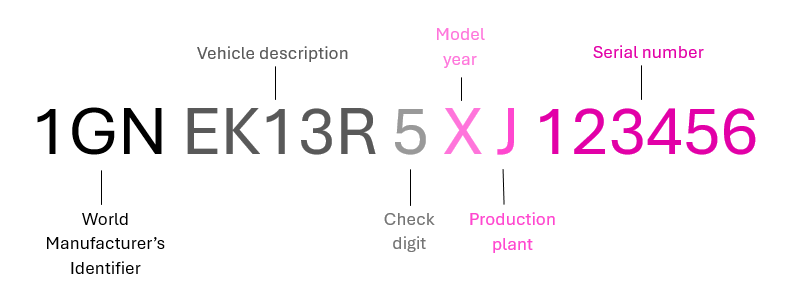
- The Savvy Promise
At Savvy, our mission is to empower you to make informed financial choices. While we maintain stringent editorial standards, this article may include mentions of products offered by our partners. Here’s how we generate income.
For Australians who own or intend to buy a car, understanding the Vehicle Identification Number (VIN) is crucial. This seemingly random string of numbers and letters holds immense significance, acting as a car's unique fingerprint throughout its lifetime. From facilitating informed decisions to ensuring safety and peace of mind, the VIN plays a vital role in various aspects of car ownership.
What is a VIN?
A VIN is a unique code assigned to every motor vehicle when it is manufactured, providing a comprehensive record of its specifications that can be used to track and identify the vehicle. Historically, VINs varied in length, from as few as 5 digits to as many as 13. However, since 1981 VINs have been standardised globally as a 17-character code. In Australia, the VIN format adheres to the International Organization for Standardization (ISO) 3779 standard, ensuring consistency and easy identification across borders.
Here's a breakdown of the VIN structure:
- Characters 1–3: these represent the World Manufacturer Identifier (WMI). This first character identifies the country of manufacture and the second and third denote the manufacturer and vehicle. For example, the WMI for Holden is 6G1 (Australia).
- Characters 4–8: this section provides details about the vehicle itself, such as the vehicle's model, body style and engine type.
- Character 9: this is a check digit, calculated mathematically using the previous nine characters. It acts as a security measure to verify the accuracy of the VIN.
- Character 10: this represents the model year of the vehicle. It can be a letter or a number, typically ranging from A (1980) to Y (2000), excluding I, O, Q, U and Z.
- Character 11: this identifies the production plant where the vehicle was assembled.
- Characters 12–17: the final six characters make up the production sequence number, which is a unique serial number assigned to each vehicle as it rolls off the assembly line. This number distinguishes one vehicle from another within the same model year, plant and production period.
What can the VIN help you with?
Knowing your car's VIN unlocks a treasure trove of information and benefits:
Informed car buying:
Before purchasing a car, especially a used one, obtaining the VIN is crucial. You can use the VIN to run a car history check through various online services or government databases. This report provides valuable insights into the vehicle's history, including:
- Previous ownership details
- Registration information
- Accident history
- Odometer readings
- Service and repair records
- Outstanding finance or security interests
- Recalls and safety issues
By accessing this information, you can make informed decisions about the car's condition, value and potential red flags, empowering you to negotiate a fair price and avoid any hidden problems.
Vehicle registration and insurance:
When registering your car or obtaining car insurance, you'll need to provide the VIN. This unique identifier helps authorities and insurers accurately identify your vehicle, streamlining the registration and insurance processes.
Parts and repairs:
When purchasing replacement parts or seeking repairs, knowing the VIN allows mechanics and parts suppliers to accurately identify compatible components specific to your car's model and specifications. This ensures you get the right parts and repairs, preventing compatibility issues and unnecessary costs.
Recalls and safety:
Manufacturers sometimes issue safety recalls to address potential defects or safety concerns in specific car models or production batches. For example, in March 2024, BMW recalled more than 7,000 cars due to a defect in the brake system. Knowing your car's VIN allows you to check online databases provided by government agencies or manufacturers to see if your car is affected by any outstanding recalls. Addressing these recalls promptly ensures your safety and the safety of others on the road. In Australia, you can find information about the latest recalls on the government’s vehicle recalls page.
Theft recovery:
In the unfortunate event of car theft, the VIN becomes critical for recovery efforts. Law enforcement agencies use the VIN to track stolen vehicles and identify them during recovery operations. Keeping a record of your car's VIN and providing it to authorities can significantly increase the chances of recovering your stolen vehicle.
Where do I find my car’s VIN?
The VIN can be found in several locations on your car:
- Driver’s side door jamb: this is the most common location, usually on a metal plate near the door latch.
- Dashboard: look for a sticker on the dashboard near the driver's side windshield.
- Engine compartment: the VIN may be etched onto the engine block or firewall.
- Vehicle registration certificate: your car's registration certificate will also have the VIN listed.
How can I protect my VIN?
While readily accessible for legitimate purposes, avoid sharing your car's VIN publicly online or with unknown individuals. Scammers and identity thieves may misuse this information for fraudulent activities like creating fake registration documents or cloning vehicles. Here are some tips for safeguarding your VIN:
- Securely store documentation: keep copies of your vehicle registration certificate, insurance documents and purchase records in a secure location – not your car. These documents contain your VIN and other sensitive information that could be used for identity theft or fraud.
- Keep it offline: be cautious about sharing your VIN and other personal information online or in public forums. Scammers and identity thieves may use this information to impersonate you or access your financial accounts.
- Consider anti-theft measures: think about installing anti-theft devices such as steering wheel locks, alarm systems and vehicle tracking devices to deter theft and improve the chances of recovery in case of theft.
- Inspect your car: periodically inspect your vehicle's VIN plate and etchings to ensure they have not been tampered with or altered. Report any discrepancies or signs of tampering to law enforcement authorities immediately.
Understanding the VIN is essential for all Australian car owners, whether you're in the market for a new car, seeking financing options or simply looking to protect your investment. If you’re looking for a new vehicle and need to secure financing, Savvy has you covered. Our expert team can offer personalised assistance to help you find an option to suit your needs. Get in touch to compare car loans with us today.
Did you find this page helpful?
This guide provides general information and does not consider your individual needs, finances or objectives. We do not make any recommendation or suggestion about which product is best for you based on your specific situation and we do not compare all companies in the market, or all products offered by all companies. It’s always important to consider whether professional financial, legal or taxation advice is appropriate for you before choosing or purchasing a financial product.
The content on our website is produced by experts in the field of finance and reviewed as part of our editorial guidelines. We endeavour to keep all information across our site updated with accurate information.
Approval for car loans is always subject to our lender’s terms, conditions and qualification criteria. Lenders will undertake a credit check in line with responsible lending obligations to help determine whether you’re in a position to take on the loan you’re applying for.
The interest rate, comparison rate, fees and monthly repayments will depend on factors specific to your profile, such as your financial situation, as well others, such as the loan’s size and your chosen repayment term. Costs such as broker fees, redraw fees or early repayment fees, and cost savings such as fee waivers, aren’t included in the comparison rate but may influence the cost of the loan. Different terms, fees or other loan amounts may result in a different comparison rate.










